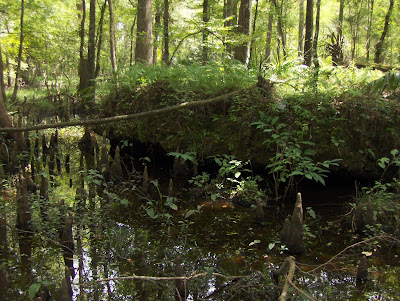After chairing the 2008 convention of the National Speleological Society, it was with great relief that I was able to attend the 2009 convention in Texas to just relax and enjoy. There were no fewer than 24 (!) scholarly symposiums; attendees typically had three or four choices of papers to hear at any given time.
I was pleased to hear that Jason Gulley, a member of my local caving club, won the Best of Show AND a Third Place ribbon in the Photo Salon. Last year another of our club’s members, Sean Roberts, also won the Best of Show.
Now down to nature…
I had long ago concluded that sediments in caves are not true soils. Soils have predictable structures and features, whereas cave sediments are less organized, like wetland sediments. Sediments wash over cave floors as they do in floodplain wetlands, and because frequent flooding or saturation keeps many of these sediments anaerobic, soil formation is inhibited. Therefore, when I saw the paper entitled “Speleosol: a subterranean soil” on the program, I just had to see it. The presenter also maintained that cave floor sediments are not true soils, but he was way ahead of me when he demonstrated that a similar formation existed on the walls of caves, sometimes on ceilings! If my memory is correct, the outer layer is a zone of accumulation, of wind- and water-borne fine sediments, microbiota, spores and pollen, even clothing lint. Below that is a layer of leaching, where the original parent rock is slowly dissolving away, its water and dissolved substances being drawn into the parent rock by capillary action. The third layer is a zone of deposition where ions, metals and other molecules are precipitated and rock density rises. The fourth layer is the parent bedrock. This wall layering of deposition, leaching, precipitation and parent material is pretty close to that of the epigean soil under your feet at a local national park. How out-of-the-box is that!
Then there was a paper on “ghost rocks.” Have you ever seen a road cut through limestone that had funny looking, upside down triangular discolorations, but still exhibiting the stratigraphy on both sides within the host rock? At first you think it is infill where the limestone has dissolved away, but you notice it maintains evidence of the surrounding layers of rock, although they seem to sag a little. I have before just ignored the stratigraphic evidence and simply called it infilling, but no, it turns out this is not the case. Instead, the limestone, which is calcium carbonate (CaCO3), has been dissolved by groundwaters and what remains are insoluble clay, sand and chert sediments that were laid down with or formed within the limestone. Caving around ghost rocks gives new meaning to caving in flatrock country.
Southeast North America has long been considered lacking in aboriginal cave art. The works done over recent decades and updated at the convention, however, have steadily documented an ever-increasing list of primitive art that proves Native American rock/cave art was as widespread as anywhere in North America. There was also a spirited discussion about whether to use mechanical means like sandblasting to remove recent spray paint from cave walls, with the issue being whether cavers can recognize and avoid destroying significant cave wall writings and etchings that might underlie the recent graffiti. I propose that any spray paint, even that which is >50 years old, be excluded from antiquities protections, and I propose that only graffiti approved by archaeological specialists be removed from cave walls.
I learned that it takes appx 10 gallons of boiling water to kill off an imported fire ant nest although the literature says only 1 – 3 gallons. There is documentation that fire ants are invading caves and predating on cave critters, many of which are rare or even imperiled. They forage in the caves at night and thus may not be noticed by cavers who cave mostly in daytime. Even aquatic trogs can suffer if ants destroy insects like Ceuthophilus crickets that feed outside caves at night and then return to the cave and deposit food (feces, eggs, shed skins) for cave aquatics to consume. I resolve to look for this impact in my local caving area.
I got introduced to the USFWS San Marcos Hatchery on a day trip. Once a fish rearing facility, it is now operated as an imperiled species live bank. The endemic Texas wild rice, Zizania texana, is imperiled by historical riparian water quantity decreases and other factors. A colony is maintained to provide for germplasm and seed and nursery stock. Ditto several cave-adapted invertebrate species that inhabit the Edwards Aquifer and are threatened by over-pumping. It may be timely to create a similar live bank of Florida’s cave crayfishes. There are more species of troglobitic crayfishes in Florida than any comparably sized place in the world, and groundwater pollution from overpopulation has become so glaring that the US EPA recently has embarrassed the state by taking over previously-delegated regulation under the Clean Water Act.
I saw my first Ramen Noodle wrestling event at the convention. I can die now. Portends of things to come was the sudden interruption of the evening gettogether by loud drumbeat music accompanying a dozen scantily clad young men and women jogging in time through the crowd in a sinuous single file, like a purposeful snake. Oh, the images… Now, guys are bigger than femmes, right? So one on one isn’t fair, right? Well, how about five or six merciless vixens against one or two skinny boys afraid to grab above the belt? The referee was a sight in his own right, too, having a vivid tie-dyed top draped over his shoulders and an eagle eye for holds barred, and he danced like a butterfly around the fighters.
The banquets were enjoyed with friends from over the years. Here are some of them, all being Gainesville cavers at some time in their lives:





















